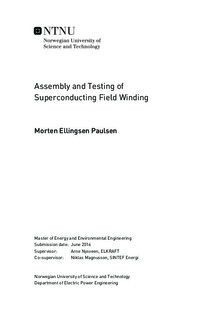Assembly and Testing of Superconducting Field Winding
Master thesis
Permanent lenke
http://hdl.handle.net/11250/2410237Utgivelsesdato
2016Metadata
Vis full innførselSamlinger
- Institutt for elkraftteknikk [2412]
Sammendrag
Superconducting rotor windings are considered for large offshore wind turbines to reduce weight, size and cost. The European project INNWIND.EU utilize various national projects in different European countries to accelerate the development of innovations that can help realize larger wind turbines. SINTEF Energy Research is one of the organizations that are involved in this project by designing, building and testing a superconducting rotor field winding. This could potentially reduce weight, volume and cost of future wind turbines.
This master thesis describes the method and steps that were done to complete a superconducting field winding and how it was tested.
Ten MgB2 double pancake coils were glued together with a thermally conductive epoxy on a thermal interface. The coils were joined electrically by a validated procedure that makes low resistance joints by using a custom made soldering tool. BSCCO high temperature superconductors were soldered at each end of the field winding to lead the current from the high temperature stage of the cryostat to the field winding. A mechanical support placed around the field winding was designed to withstand the magnetic forces acting on the field winding during testing.
The field winding was placed in a cryostat and cooled down to 17.7K for testing. Seven out of ten coils were proved to be superconductive. Coil 1, 6, 10 and the BSCCO HTS were not superconductive as a voltage was measured when a current was flowing through the field winding. The quality of the joints was validated by measuring the voltage over each joint and calculating the resistance. The average resistance of the joints was 40nOhms where the highest resistance was 110nOhms. 15mW of heat would be dissipated in the joints when testing with a current of 200A. The inductance of the field winding was found to be 4.6H.
